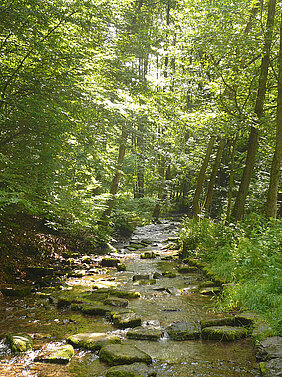Comprehensive monitoring data for many so-called PMT/vPvM-substances is still scarce. A large-scale surface water monitoring program in Lower Saxony now sheds light on the situation and reveals potential risks.
Thanks to fundamental progress in analytical techniques, persistent, mobile and possibly toxic as well as very persistent and very mobile compounds - summarized under the term PMT/vPvM-substances - have increasingly been the focus of water and environmental research. Most of these compounds enter the aquatic environment via the wastewater pathway and can be translocated between different water compartments. Thus, if polluted surface waters are used as resource for drinking water production, these compounds can potentially pose a challenge to drinking water supplies. On the other hand, surface water ecology may also be at risk from the presence of these compounds. However, no comprehensive information is yet available on the occurrence of many PMT/vPvM-substances in rivers and lakes.
The aim of our study was to develop analytical methods for the determination of a large number of PMT/vPvM substances and to perform comprehensive monitoring for these substances in surface waters in Lower Saxony. Substances for which there was little or no information available on their occurrence in surface waters were the particular focus of the study. Pharmaceutical residues as well as industrial chemicals and other substances not related to pharmaceuticals were considered.
Some of the substances that had previously received little attention stood out in particular during the study. These were the pharmaceutical metabolites torasemide carboxylic acid (in 93% of all samples, up to 1.2 μg/L), losartan acid (52 %, up to 0.30 μg/L) and ramiprilate (51 %, up to 0.22 μg/L), the UV-stabilizer ensulizole (83 %, up to 2.3 μg/L), and the vulcanization accelerator 1,3-diphenylguanidine (71 %, up to 0.16 μg/L). The highest individual concentration was observed for cyanuric acid (49 μg/L). The Ems River was identified as a contamination hot-spot for trifluoromethanesulfonic acid (up to 0.52 µg/L), a substance that was otherwise rarely detected.
To estimate a potential ecological risk of the substances detected in at least 20 % of all samples, modeled and experimentally derived PNEC (predicted no-effect concentration) and proposed environmental quality standards were related to measured environmental concentrations (MEC). An ecological risk - defined as the risk quotient MEC/PNEC ≥ 1 - for losartan acid and torasemide carboxylic acid cannot be excluded to the lack of experimental ecotoxicological data. Due to the potential drinking water relevance of ensulizole, torasemide carboxylic acid and cyanuric acid, an orientational investigation of surface water-influenced groundwater bodies for these parameters is recommended. In the case of trifluoromethanesulfonic acid, this recommendation applies to the area of the Ems River.

![[Translate to English:] Prüfstelle-Produktprüfung_Teststand Test centre and product testing](/fileadmin/_processed_/0/9/csm_TZW-Karlsruhe_Pruefung_Geraete-Teststand_377188946c.jpg)
























